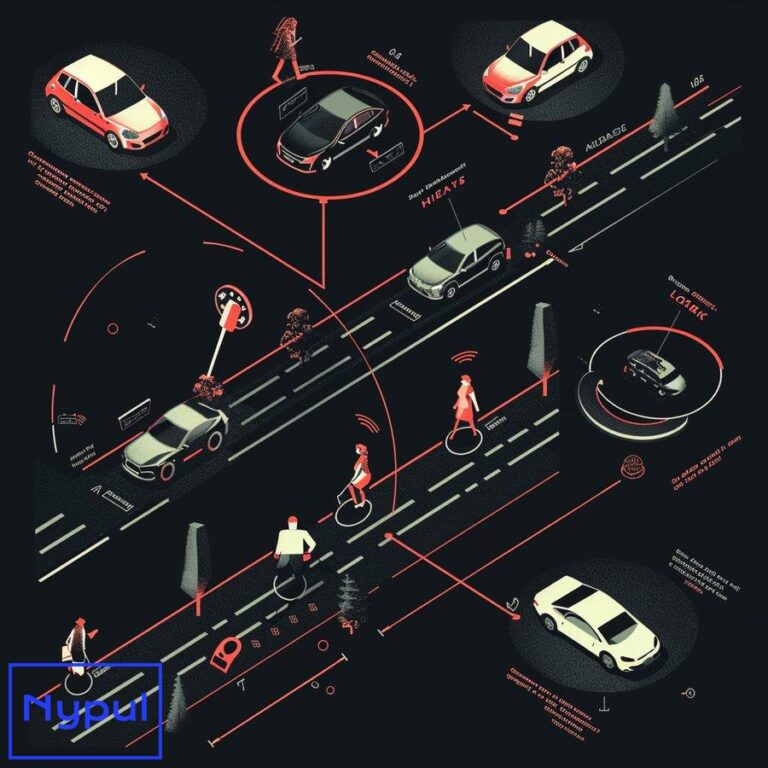What Is the Radius of Last Mile Delivery
Last mile delivery, the final step in the supply chain process, plays a crucial role in customer satisfaction and operational efficiency for businesses. Understanding the radius of last mile delivery is essential for optimizing logistics strategies and meeting consumer expectations. This comprehensive guide explores the various aspects of last mile delivery radius, its influencing factors, and strategies for improvement.
What defines the last mile delivery radius?
The last mile delivery radius refers to the maximum distance a package travels from the final distribution center or warehouse to its ultimate destination, typically the customer’s doorstep. This radius is not a fixed measurement but rather a dynamic concept that varies based on numerous factors.

Geographical boundaries: The last mile delivery radius is often defined by geographical boundaries such as city limits, postal codes, or specific neighborhoods. These boundaries help logistics providers organize their delivery routes and allocate resources efficiently.
Time constraints: The radius is frequently determined by the maximum time allowed for a delivery to reach its destination. This time-based approach ensures that deliveries can be completed within promised timeframes, which is crucial for customer satisfaction.
Cost considerations: Economic factors play a significant role in defining the last mile delivery radius. Businesses must balance the cost of extending their delivery range against potential revenue and customer satisfaction gains.
Operational capacity: The available workforce, vehicle fleet, and technological infrastructure of a logistics provider can limit or expand the practical last mile delivery radius.
Customer density: Areas with a higher concentration of customers may have a smaller radius, as more deliveries can be completed in a shorter distance. Conversely, regions with sparse populations might require a larger radius to be economically viable.
Regulatory restrictions: Local laws and regulations, such as traffic rules, parking restrictions, or noise ordinances, can impact the feasible delivery radius in certain areas.
The interplay of these factors results in a last mile delivery radius that is unique to each business and location. For example, a dense urban area might have a radius of just a few miles, while a rural region could extend to dozens of miles. Understanding these defining elements is crucial for businesses aiming to optimize their last mile operations and meet customer expectations effectively.
How does the last mile radius differ between urban and rural areas?

The last mile delivery radius exhibits significant variations between urban and rural areas due to distinct characteristics of each environment. These differences impact logistics strategies, costs, and customer expectations.
Urban Last Mile Radius
Urban areas typically have a smaller last mile delivery radius compared to rural regions. This compact radius is attributed to several factors:
Population density: Cities have a higher concentration of residents and businesses, allowing for more deliveries within a smaller geographical area. This density enables logistics providers to optimize routes and reduce travel distances between stops.
Infrastructure: Urban environments often boast well-developed road networks, public transportation systems, and advanced telecommunications infrastructure. These elements facilitate more efficient delivery processes and support technologies like real-time tracking and route optimization.
Traffic congestion: While cities have better infrastructure, they also face challenges with traffic congestion. This can limit the practical delivery radius as travel times increase, even for short distances.
Diverse delivery options: Urban areas often offer a variety of delivery methods, including bike couriers, walking deliveries, and even drone deliveries in some cases. These alternatives can help maintain a smaller radius while ensuring timely deliveries.
Regulatory constraints: Cities frequently have stricter regulations on parking, noise, and delivery hours, which can impact the feasible delivery radius and operational strategies.
Rural Last Mile Radius
Rural areas, in contrast, typically have a much larger last mile delivery radius:
Sparse population: With fewer residents spread over larger areas, rural regions require a wider radius to reach a sufficient number of customers and maintain economic viability.
Limited infrastructure: Rural areas often have less developed road networks and may lack advanced logistics infrastructure. This can necessitate longer travel times and distances for deliveries.
Fewer delivery hubs: The scarcity of distribution centers in rural areas means that packages often need to travel further from their last sorting location to the final destination.
Reduced traffic congestion: While rural areas benefit from less traffic, the longer distances between delivery points can still result in extended delivery times.
Challenging terrain: Rural deliveries may encounter obstacles such as unpaved roads, mountainous regions, or areas with limited GPS coverage, further expanding the necessary delivery radius.
Comparative Analysis
To illustrate the stark differences between urban and rural last mile delivery radii, consider the following table:
| Characteristic | Urban Radius | Rural Radius |
|---|---|---|
| Typical Range | 1-5 miles | 10-50+ miles |
| Population Density | High (1,000+ per sq mile) | Low (< 100 per sq mile) |
| Delivery Stops per Hour | 10-20 | 2-5 |
| Primary Vehicle Types | Vans, bikes, on foot | Trucks, vans |
| Infrastructure Quality | High | Variable |
| Traffic Congestion | High | Low |
| Delivery Options | Diverse | Limited |
These differences in last mile delivery radii between urban and rural areas necessitate distinct strategies for logistics providers. Urban deliveries focus on navigating dense networks efficiently, while rural deliveries prioritize covering large distances cost-effectively. Understanding these variations is crucial for businesses aiming to provide consistent service across diverse geographical regions.
What factors influence the size of the last mile delivery radius?

The size of the last mile delivery radius is influenced by a complex interplay of various factors. Understanding these elements is crucial for logistics providers and businesses to optimize their delivery operations and meet customer expectations effectively.
Customer expectations
Modern consumers have increasingly high expectations for delivery speed and flexibility. These expectations can significantly impact the last mile delivery radius:
Same-day delivery demands: The growing popularity of same-day delivery services in urban areas often necessitates a smaller delivery radius to ensure timely fulfillment.
Delivery time windows: Customers’ preferences for specific delivery time slots can affect route planning and, consequently, the practical delivery radius.
Infrastructure and geography
The physical environment and available infrastructure play a crucial role in determining the last mile delivery radius:
Road network quality: Well-maintained roads and efficient highway systems can extend the practical delivery radius by reducing travel times.
Urban density: Highly concentrated urban areas may require a smaller radius due to traffic congestion and parking limitations.
Natural barriers: Geographical features such as rivers, mountains, or islands can significantly impact the feasible delivery area.
Economic factors
Financial considerations are paramount in determining the viable last mile delivery radius:
Fuel costs: Higher fuel prices may lead to a reduction in the delivery radius to maintain profitability.
Labor expenses: The cost of drivers and other delivery personnel can influence the economically viable delivery range.
Vehicle maintenance: The expenses associated with maintaining a delivery fleet impact the sustainable delivery radius.
Operational capacity
The resources and capabilities of the logistics provider directly affect the last mile delivery radius:
Fleet size and composition: The number and types of vehicles available for deliveries can limit or expand the delivery range.
Workforce availability: The size of the delivery team and their scheduling flexibility impact the manageable delivery area.
Technological capabilities: Advanced routing software and real-time tracking systems can help extend the effective delivery radius by improving efficiency.
Market competition
The competitive landscape in the delivery sector influences the last mile radius:
Competitor offerings: If rival companies offer larger delivery radii, businesses may feel pressured to expand their own to remain competitive.
Market saturation: In areas with numerous delivery providers, companies might opt for a smaller, more focused delivery radius to maintain service quality.
Regulatory environment
Legal and regulatory factors can significantly impact the last mile delivery radius:
Local regulations: City ordinances regarding delivery times, vehicle types, or environmental standards can affect the practical delivery range.
Zoning laws: Restrictions on the location of distribution centers can influence the starting point of last mile deliveries and, thus, the overall radius.
Environmental considerations
Sustainability concerns are increasingly shaping last mile delivery strategies:
Emission regulations: Stricter environmental policies may encourage the use of electric vehicles or alternative delivery methods, potentially altering the feasible delivery radius.
Green initiatives: Companies’ commitments to reducing their carbon footprint might lead to adjustments in their delivery radius to optimize for sustainability.
Seasonal variations
The time of year can have a significant impact on the last mile delivery radius:
Weather conditions: Severe weather can temporarily reduce the practical delivery radius due to safety concerns and increased travel times.
Holiday peaks: During high-volume periods like holidays, companies might strategically shrink their delivery radius to manage increased demand effectively.
Understanding and balancing these diverse factors is essential for businesses aiming to optimize their last mile delivery operations. By carefully considering each element, companies can determine the most effective delivery radius that balances customer satisfaction, operational efficiency, and profitability.
How does delivery speed expectation impact the last mile radius?
Delivery speed expectations have become a critical factor in shaping the last mile delivery radius. As e-commerce continues to grow and consumer demands evolve, the pressure to provide faster deliveries has intensified, directly influencing the geographical scope of last mile operations.
The evolution of delivery speed expectations

Consumer expectations for delivery speed have undergone a significant transformation in recent years:
Standard delivery: Traditionally, customers were content with delivery times of 5-7 business days. This allowed for a larger last mile radius as time constraints were less stringent.
Two-day delivery: The introduction of two-day shipping options, popularized by major e-commerce players, began to shrink the practical delivery radius for many businesses.
Next-day delivery: As next-day delivery became more common, companies had to further optimize their logistics networks, often resulting in a reduced last mile radius to meet these tighter deadlines.
Same-day delivery: The latest frontier in delivery speed, same-day service, has had the most dramatic impact on the last mile radius, often limiting it to a very localized area around distribution centers.
Impact on logistics strategies
The push for faster deliveries has led to significant changes in how companies approach their last mile operations:
Decentralized distribution: To meet rapid delivery expectations, businesses are moving away from centralized warehouses to a network of smaller, localized distribution centers. This strategy effectively reduces the last mile radius for each facility while expanding the overall coverage area.
Hub-and-spoke models: Companies are adopting hub-and-spoke distribution systems, where central hubs feed into smaller, local spokes. This approach allows for a balance between inventory consolidation and rapid local delivery, influencing the effective last mile radius.
Urban micro-fulfillment centers: In dense urban areas, some businesses are establishing micro-fulfillment centers—small-scale distribution points located closer to customers. These centers significantly shrink the last mile radius but enable ultra-fast deliveries.
Challenges and trade-offs
The drive for faster deliveries and its impact on the last mile radius presents several challenges:
Cost implications: Shrinking the delivery radius to accommodate faster speeds often leads to increased operational costs, which may be passed on to consumers or absorbed by the business.
Inventory management: Maintaining stock across multiple smaller distribution points to support a reduced delivery radius can complicate inventory management and potentially increase overall inventory costs.
Environmental concerns: Faster deliveries with smaller radii might lead to more frequent, less-than-full vehicle trips, potentially increasing carbon emissions and contradicting sustainability goals.
Balancing speed and coverage
To illustrate the relationship between delivery speed expectations and last mile radius, consider the following table:
| Delivery Speed | Typical Last Mile Radius | Primary Challenges |
|---|---|---|
| Standard (5-7 days) | 50-100+ miles | Inventory forecasting, route optimization |
| Two-day | 20-50 miles | Balancing stock across distribution centers |
| Next-day | 10-30 miles | Increased operational costs, fleet management |
| Same-day | 1-10 miles | High infrastructure investment, limited coverage |
This table demonstrates how increasing speed expectations generally correlate with a decreasing last mile radius. However, the exact figures can vary based on factors such as population density, infrastructure, and business model.
Strategies for managing speed expectations
Businesses are employing various strategies to balance speed expectations with practical last mile radii:
Tiered delivery options: Offering multiple delivery speed options allows customers to choose between faster, more localized deliveries and slower, potentially cheaper options with a larger radius.
Dynamic pricing: Implementing pricing models that reflect the true cost of different delivery speeds and radii can help manage customer expectations and maintain operational efficiency.
Partnerships and collaborations: Some companies are partnering with local courier services or leveraging gig economy platforms to extend their effective delivery radius without significant infrastructure investment.
Technology integration: Advanced routing algorithms, real-time tracking, and predictive analytics are being employed to maximize efficiency within given delivery radii, potentially allowing for faster deliveries without necessarily shrinking the coverage area.
The impact of delivery speed expectations on the last mile radius is profound and ongoing. As consumer demands continue to evolve, businesses must constantly reassess and adapt their strategies to find the optimal balance between speed, cost, and coverage. The challenge lies in meeting these expectations while maintaining profitability and sustainability in last mile operations.
What role does warehouse location play in determining the last mile radius?
Warehouse location is a critical factor in determining the last mile delivery radius, significantly influencing the efficiency, cost-effectiveness, and speed of deliveries. The strategic placement of warehouses can either expand or constrain the practical last mile radius, making it a crucial consideration for businesses aiming to optimize their logistics operations.
Strategic importance of warehouse location
The location of warehouses serves as the starting point for last mile deliveries, directly impacting several key aspects of the logistics process:
Proximity to customers: Warehouses situated closer to major population centers or key customer clusters can support a smaller, more efficient last mile radius.
Access to transportation networks: Locations with easy access to highways, airports, or ports can extend the effective delivery radius by reducing transit times.
Labor availability: Warehouses in areas with a robust workforce can support more extensive operations, potentially allowing for a larger last mile radius.
Cost considerations: Real estate costs, taxes, and operational expenses associated with different locations can influence the feasible size of the last mile radius.
Impact on last mile radius
The relationship between warehouse location and last mile radius is multifaceted:
Urban warehouses
Warehouses located in or near urban centers typically support a smaller last mile radius but offer several advantages:
Faster deliveries: Proximity to dense customer populations enables rapid order fulfillment and delivery.
Reduced transportation costs: Shorter distances to final destinations can lower fuel consumption and vehicle wear.
Flexibility: Urban locations often allow for diverse delivery methods, including bicycles or on-foot deliveries for ultra-short radii.
Challenges: Higher real estate costs and potential space limitations can constrain operations.
Suburban warehouses
Facilities in suburban areas often strike a balance between urban proximity and operational scale:
Moderate radius: These locations typically support a medium-sized last mile radius, balancing reach and speed.
Cost-effective operations: Lower real estate costs compared to urban centers can allow for larger facilities and potentially more extensive delivery radii.
Traffic considerations: Suburban locations may offer easier highway access but can still face congestion during peak hours.
Rural warehouses
Warehouses in rural areas generally necessitate a larger last mile radius:
Extended coverage: These locations often serve wider geographical areas due to lower population density.
Lower operational costs: Reduced real estate and labor costs can offset the expenses of covering larger delivery radii.
Challenges: Longer distances to major population centers can increase delivery times and transportation costs.
Comparative analysis
To illustrate the impact of warehouse location on last mile radius, consider the following table:
| Warehouse Location | Typical Last Mile Radius | Key Advantages | Primary Challenges |
|---|---|---|---|
| Urban Center | 1-10 miles | Rapid delivery, high customer density | High costs, space limitations |
| Suburban | 10-30 miles | Balance of speed and coverage, moderate costs | Traffic congestion, varied customer density |
| Rural | 30-100+ miles | Lower operational costs, large coverage area | Extended delivery times, higher transportation costs |
This comparison demonstrates how warehouse location significantly influences the practical last mile delivery radius, with each type of location offering distinct advantages and challenges.
Strategies for optimizing warehouse location
Businesses employ various strategies to leverage warehouse location for optimal last mile performance:
Hub-and-spoke model: Utilizing a central warehouse (hub) to feed smaller, strategically located distribution centers (spokes) can help balance inventory management with rapid local deliveries.
Network optimization: Regularly analyzing delivery patterns and customer locations to adjust warehouse placements and delivery radii for maximum efficiency.
Multi-tier inventory systems: Storing fast-moving items in urban micro-fulfillment centers while keeping slower-moving inventory in larger, more distant warehouses to optimize the last mile radius for different product types.
Seasonal adjustments: Temporarily leasing additional warehouse space in strategic locations during peak seasons to manage increased demand without permanently expanding infrastructure.
Partnerships with third-party logistics providers: Collaborating with 3PLs can allow businesses to leverage existing warehouse networks and adjust their effective last mile radius without significant capital investment.
Technology integration: Implementing advanced warehouse management systems and predictive analytics to optimize inventory placement and routing, potentially extending the effective last mile radius without changing physical locations.
Considerations for e-commerce businesses
For e-commerce companies, the role of warehouse location in determining the last mile radius is particularly crucial:
Inventory distribution: Balancing stock across multiple warehouses to ensure products are always within a feasible delivery radius of potential customers.






